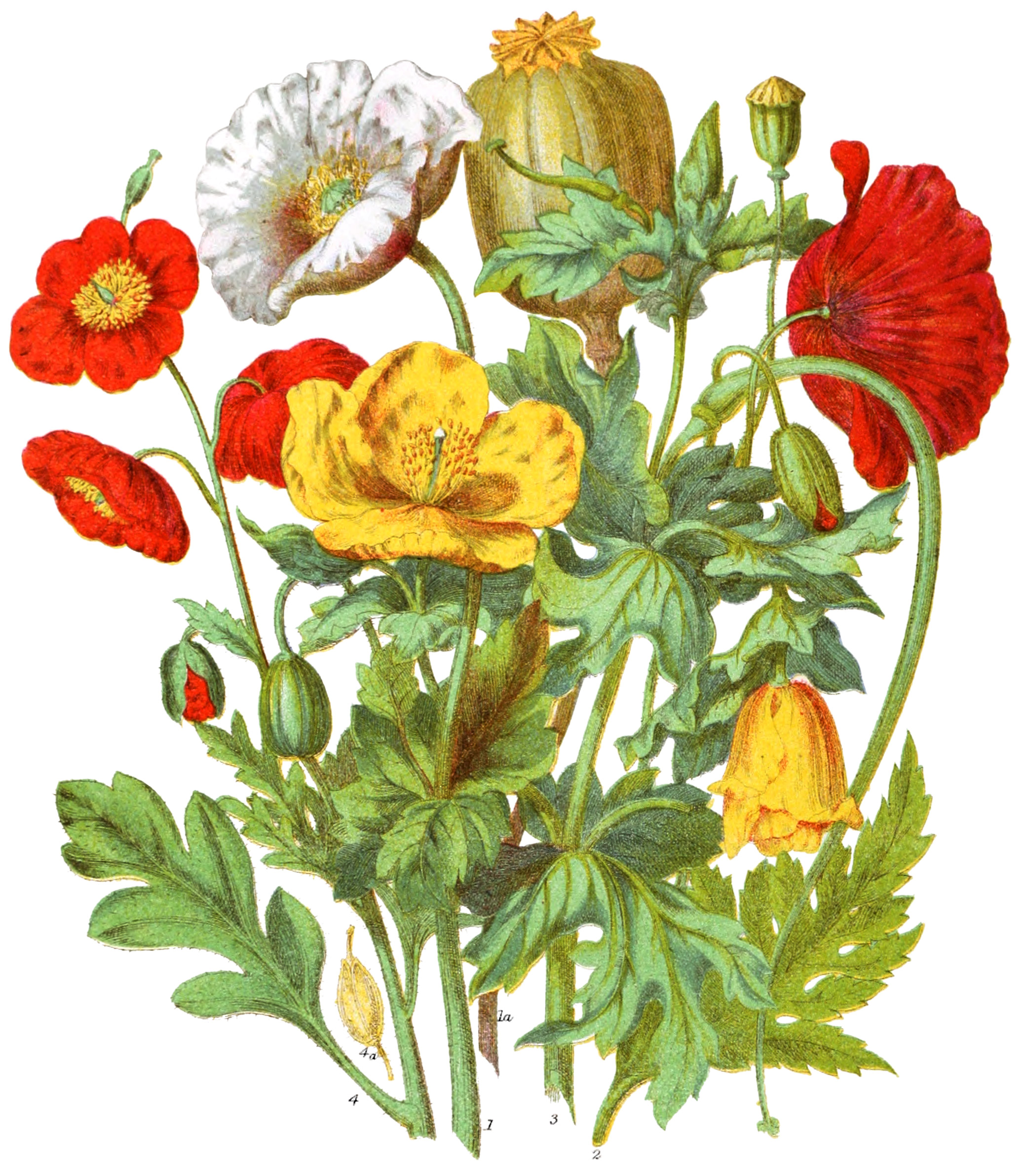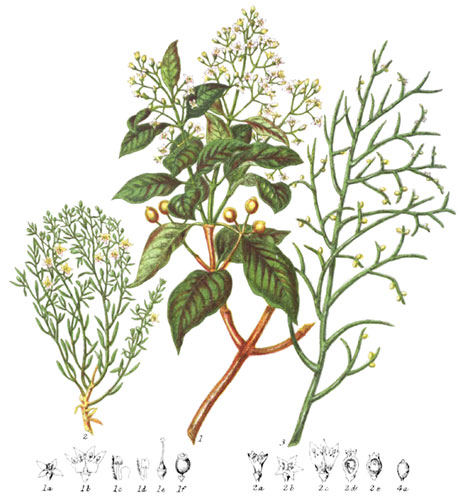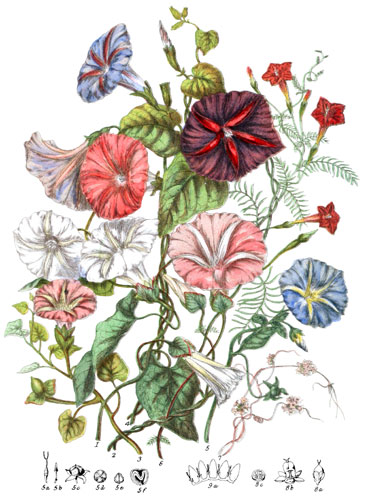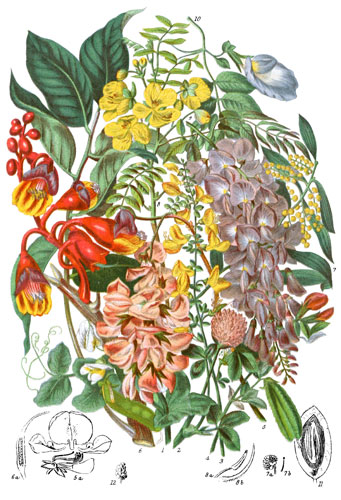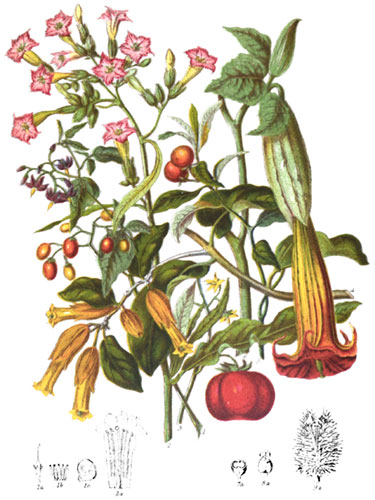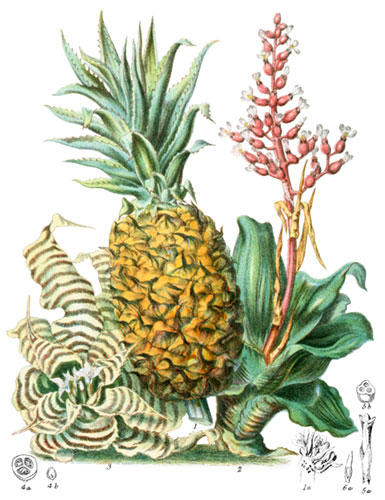Key characteristics
Herbaceous plants and shrubs; leaves alternate on the stem, either simple or divided; without stipules at the base of the leaf-stalk. The flower-stalks are generally long, bearing flowers singly; the calyx is composed of only two or three sepals, which fall off when the flower expands; the petals are usually four, sometimes six,—in Bocconia they are wanting. In the bud state the petals are usually crumpled. Stamens numerous, attached to the base of the pistil, the style of which is short; stigmas, either two or many, forming a rayed star on the top of the ovary. The seed-vessel is either a capsule as in the Poppy, or long and pod-shaped as in Glaucium, the Horn Poppy, containing numerous seeds of a fleshy, oily nature.
Select plants in this order
Not all plants listed are illustrated and not all plants illustrated are listed.
- A milky juice pervades the plants of this Order, possessing narcotic properties; it abounds in the full-grown capsules of Paper somniferum, the Opium Poppy (1). This plant grows in sandy ground in the fen districts of England, but is much more plentiful in the south of Europe, where it was probably first introduced from the East. In Germany it is cultivated chiefly for the sake of the seeds, the oil contained in them being used for various purposes; mixed with olive oil, it is much employed in cookery. The opium Poppy was known and cultivated by the ancients in the time of Dioscorides, and Homer mentions it as being valuable for assuaging the agonies of wounded heroes. In the East it is grown in very large quantities for the opium, which is obtained from incisions made in the half-ripe capsules: when thickened by exposure to the sun, and made into cakes, it is a great article of commerce throughout the East.
- Glaucium luteum (3) grows on many parts of the coast of England, among the loose stones and sandy oil; the singular pale-green foliage, and the bright yellow flowers, adorning the barren shore.
- Chelidonium, or Celadine, is common on waysides in many parts of England; it is said to have been so called after the Greek named of the swallow, as it appears about the time of the arrival of that bird, and withers at its departure in the autumn. The whole plants contains an orange-coloured juice of intensely acrid property, which is used medicinally for the eyes.
- Argemone Mexicana, a garden-plant in this country, is a common week in the West Indies, with a prickly fruit about the size of a fig; this abounds in a thick milky juice, which congeals and becomes yellow in the open air, resembling gamboge. It is considered beneficial in medicine both in the East and West Indies; and the Brazilians employ it as a remedy against the bite of serpents.
- Sanguinaria Canadensis, which grows in the woods of Canada, has an abundant red juice in all its parts, with which the Indians stain themselves; the root is tuberous and fleshy: from each tuber grows a single leaf, and a stalk bearing one delicate white flower.
- Some plants of this tribe form connecting links with other tribes. The long pods of Glaucium and Eschscholtzin very nearly resemble in appearance those of the cruciferous tribe. Platystemon, a genus found in California and Sibera, forms a link with the Crowfoot tribe.
- The prevailing colours of the flowers are yellow, red, and white; none are blue, although Glaucium violaceum is of a purple hue.
- Papaver affords one of the very few instances of a red flower in England, and it is remarkable that these all occur in exposed sunny places, chiefly in corn-fields,—a fact that coincides with other observations on the necessity of a bright sunlight for the development of a red colour. In preparing carmine, it has been found essential to carry on the process in the full light of the sun.
Locations
The different plants of this Order are dispersed most abundantly in Europe, scattered species being found but rarely in other parts of the world. Two are known to belong to Siberia, three to China and Japan, one to the Cape of Good Hope, one to North America, and six to tropical America. Those which are perennial are chiefly natives of mountainous districts Papaver ræas (2) and P. dubium of England are now found in gardens in India, probably introduced from Europe. Papaver glabrum, the only native Indian species, grows in corn-fields on the terraced slopes of the Himalayas, at an elevation of from 5000 to 7000 feet. Meconopsis is the most widly-scattered genus of this Order; M. cambrica belonging to Westmoreland and Wales; M. aculeata being common on the Himalayas, and other species growing in North America.
Legend
- Papaver somniferum, Opium Poppy.
- Capsule.
- Papaver Rhæas, Common Corn-poppy. Corn-fields, England.
- Glaucium luteum, Yellow Horn-poppy. Sandy Sea-shores, England.
- Meconopsis aculeata. Himalayas.
- Seed-vessel.
Explore more
Posters
Decorate your walls with colorful detailed posters based on Elizabeth Twining’s beautiful two-volume set from 1868.
Puzzles
Challenge yourself or someone else to assemble a puzzle of all 160 botanical illustrations.
